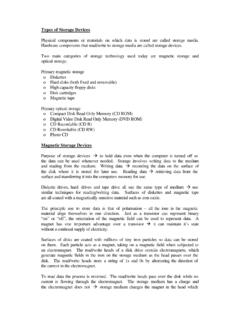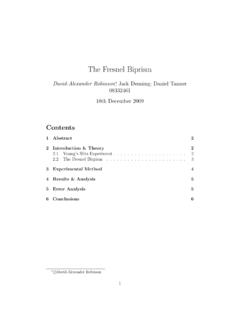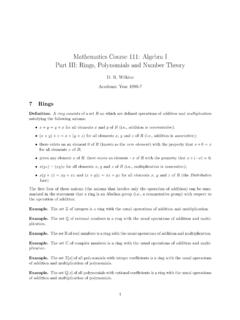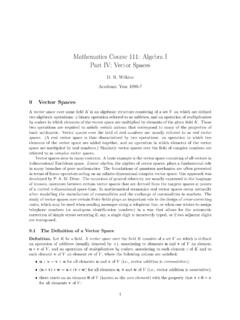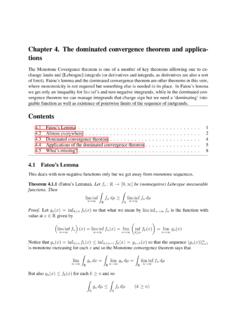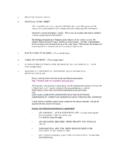Transcription of Six Steps to Completing a Mail-Merge
1 Six Steps to Completing a Mail-Merge mail merging means to plug data from an address table into form letters, e- mail messages, envelopes, address labels, or a directory (a list or catalog, for example). To start a mail merge , choose Tools | Letters and Mailings | mail merge Wizard to open the mail merge task pane. step 1: Select a Document Type The first step is to select what Word calls a document type in the mail merge task pane, what kind of Mail-Merge you want to undertake: form letters, e- mail messages, envelopes for mass-mailings, labels for mass-mailings, or a directory (a list or catalog).
2 Choose an option button and click Next at the bottom of the task pane to go to step 2. step 2: Select a Starting Document What Word calls the starting document is the document in which the merging takes place. In other words, the address or other data you retrieve will land in the document you choose or create now. You can create a new start document or use an existing one. In the case of labels and envelopes, you tell Word what size labels or envelopes you intend to print on. In the case of form letters, e- mail messages, and directories, you supply the text either by making use of a document you ve written already or writing a new document.
3 step 3: Select Recipients In step 3, you tell Word where to get the data that you will merge into the starting document you created or supplied in step 2. You can retrieve the data from a table in a Word document, an Access database table or query, or the address book or contact list where you store your addresses. You can also create a new list for the data if you haven t entered the data in a file yet. step 4: Write/Arrange Your Document In step 4, you insert the merge fields, the parts of the starting document that differ from recipient to recipient.
4 By inserting merge fields, you tell Word where to plug information from the data source into the starting document. You also tell Word which data to take from the data source. Word offers special tools for entering an address block the recipient s address, including his or her name, company, title, street address, city, and zip code. step 5: Preview Your Document In step 5, you get a chance to see what your form letters, e- mail messages, envelopes, labels, or directory will look like after they are printed or sent.
5 In this step , you find out what the document will look like when real data is plugged into it. If something is amiss in the document, you can click the Previous link to return to step 4, the Write/Arrange your document task pane, and make changes there. step 6: Complete the merge step 6 is where you complete the merge by either printing a new document or saving the new file and printing it later. By saving the merged data in a new file, you can edit the file before printing it. In the case of e- mail messages, you click the Electronic mail link to tell Word to send the e- mail messages.
6 Preparing and Selecting the Data Source The data source is the file where the addresses and other information is kept. step 3 of the Mail-Merge procedure calls for you to name your data source, and before you name it, make sure that it is in good working order. The data source can be any number of things, as mentioned above. Word also offers a special dialog box for creating a data source from scratch and storing it in Microsoft Access. Caution: After you create the data source, do not move it to a different folder or rearrange the merge fields/columns.
7 If you do so, the document can t read the data source correctly and you can t complete the Mail-Merge . Note: A field is one category of information (like last name, or zip code). A record comprises all the data about one person or thing. The field is the heading of a table, while records are all of the data underneath. Using a Word Table as the Data Source For people who aren t familiar with databases, the easiest type of data source to manage is a Word table. Either create an address table from scratch or copy a table you have already created and save the table by itself in a document.
8 Save the table under a name you will recognize. When you merge the data source table with the starting document, you will be asked to locate and select the document that holds your addresses or other to-be-merged information. To use a Word table as the data source, the table must meet these standards: o A descriptive heading must appear across the top of each column. The row of descriptive headings across the top of a table is called the header row, or sometimes the heading row. The names in the header row double as merge field names when you insert merge fields in the starting document.
9 When you tell Word where to plug data into the starting document, you choose a column name from your table. o No text or blank lines can appear above the table in the document. To be on the safe side, save the table in a document by itself. To use a Word table as a data source, click the Use an Existing List option button in the mail merge task pane in step 3, and then click on the Browse hyperlink on the task pane or the Open Data Source button on the mail merge toolbar. The Select Data Source dialog box appears.
10 Select the Word document with the table you need and click the Open button. Constructing an Access Data Source File During the Mail-Merge If you haven t yet created a table or database table with the information you want to merge , you can create a data source with Word s help. When you are done, you will have created a Microsoft Access database. To create an Access database table from scratch and use it as the data source in a Mail-Merge , start during step 3 of the Mail-Merge . Choose the Type a New List option button in the mail merge task pane, and then click the Create hyperlink.



